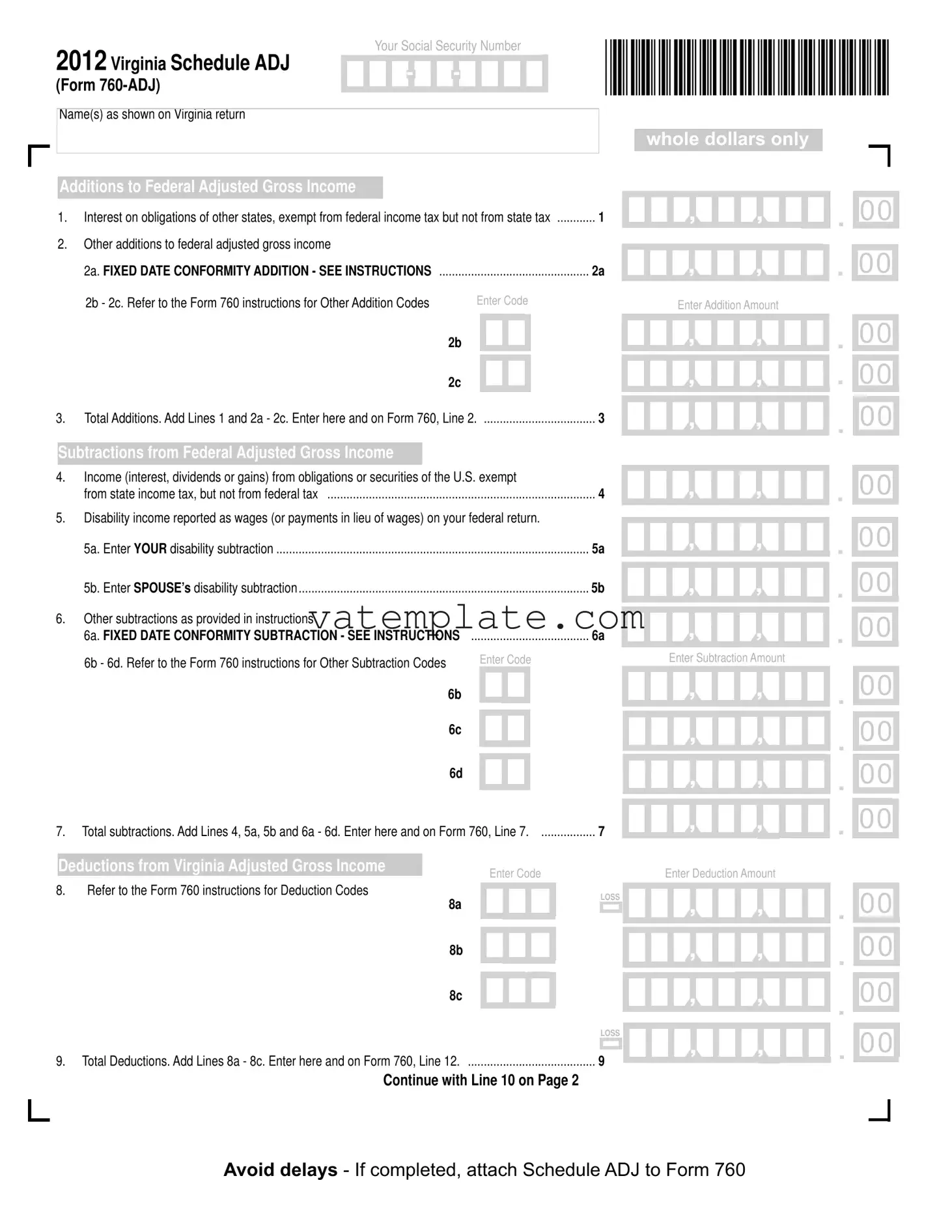The Virginia Schedule ADJ form is used to make specific adjustments to an individual's federal adjusted gross income for their Virginia state income tax return. These adjustments include additions and subtractions to income that are specific to Virginia tax laws, helping to determine the correct Virginia adjusted gross income (VAGI).
Who needs to fill out the Virginia Schedule ADJ?
Any Virginia taxpayer who needs to adjust their federal adjusted gross income for their state tax return must complete the Schedule ADJ. This includes those who have specific types of income that are taxed differently at the state level, or who qualify for deductions or credits unique to Virginia.
What are some examples of additions to income on the Schedule ADJ?
Examples of additions to income on the Schedule ADJ include:
-
Interest on obligations of other states, which is exempt from federal income tax but not exempt from Virginia state tax.
-
Fixed Date Conformity additions, which adjust for differences between federal and state tax laws regarding the taxation of certain income.
These adjustments ensure that income taxed at the federal level but exempt at the state level (or vice versa) is appropriately accounted for on the Virginia tax return.
Can you explain the subtractions from income listed on the Virginia Schedule ADJ?
The Virginia Schedule ADJ allows for certain subtractions from federal adjusted gross income to calculate VAGI properly. Key subtractions include:
-
Income from U.S. obligations, securities, or bonds exempt from Virginia state income tax.
-
Disability income reported as wages on the federal return, which Virginia may allow to be subtracted.
-
Fixed Date Conformity subtractions, reflecting differences between federal and Virginia tax law on reportable income.
These subtractions ensure that income that is not subject to Virginia state tax does not increase the tax liability of the taxpayer.
How do deductions on the Virginia Schedule ADJ work?
Deductions on the Virginia Schedule ADJ are amounts that can be subtracted from VAGI to further reduce a taxpayer's taxable income. Taxpayers must reference specific deduction codes provided in the Virginia tax form instructions to properly report these deductions. Examples include certain job-related expenses, education-related expenses, and other Virginia-specific deductions.
The Virginia Earned Income Credit (EIC) is a credit for low to moderate-income working individuals and families, mirroring the federal EIC but at a state level. On the Schedule ADJ, taxpayers can calculate a portion of the credit they are entitled to, based on the amount claimed on their federal return, and then multiply this amount by 20%. The result is compared against another potential credit calculation based on the number of personal exemptions, and the taxpayer can claim the greater of the two amounts as their Virginia EIC.
If a taxpayer has more than four exemptions to report and the Schedule ADJ form does not provide enough space, they should attach a separate schedule. This schedule should list the names, Social Security Numbers (SSNs), and Virginia Adjusted Gross Incomes (VAGIs) for each additional exemption, ensuring that all qualifying individuals are accounted for.
What are the penalties and interests sections for on the Virginia Schedule ADJ?
These sections allow taxpayers to calculate and report any additional amounts owed due to penalties for late filing or payment, extensions, and any interest accrued on unpaid taxes. It's important that taxpayers accurately calculate these amounts to avoid underpaying their tax bill and incurring further penalties.
How does one contribute to a School or Library Foundation through the Virginia Schedule ADJ?
Taxpayers have the option to make voluntary contributions to designated School or Library Foundations through the Virginia Schedule ADJ by entering the code for the foundation(s) and the amount of the contribution in the specified fields. If contributing to more than three foundations, instructions on the form guide taxpayers on how to properly report and sum these voluntary contributions.


